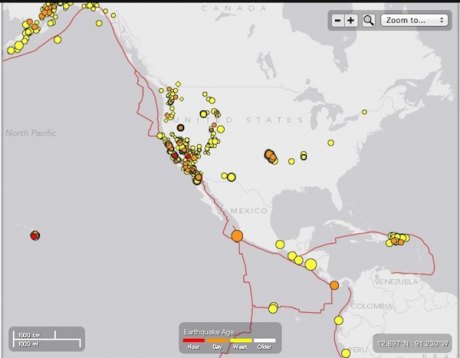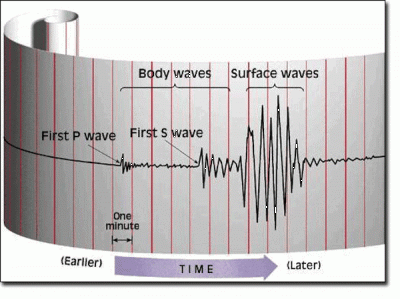Ummmm….. What Was That?
Last Saturday, I was sitting behind the counter at the Visitor Center, where I work, chatting with my friend and NPS employee Sarah, when all of a sudden..."BOOM!" Sarah noticed the building make an unusual sound and felt it vibrating, while I noticed the mugs that we have for sale clinking against one another. Sarah described how the building felt like it was shaking from the ground up, something a bit different from what we experience during severe weather. We began trying to reason what the "BOOM!" was. Wind maybe? With wind speeds topping out around 6 miles per hour yesterday and the odd "feel" of the event, the likelihood of the wind causing the noises and movement were slim. Then we thought it might have been a sonic boom! When the sound barrier is broken, it is definitely loud and will make you shudder, but the "boom" we experienced sort-of rumbled and boomed, making it different, so we decided it probably wasn't caused by a jet.
At 12:16pm, I turned to social media and posted "Sooooooo the Visitor Center just shook for a few seconds..." on my Facebook page. Within a few minutes, a couple people had commented they too felt the shake on Ocracoke. One person commented the shake was felt in Nags Head, which is about 83 miles north of Ocracoke, which led me and Sarah to truly believe this was no sonic boom or gust of wind.
Throughout history, "booms" have been reported all over the globe. Frequently the booms are caused by humans; jets breaking the sound barrier, explosions, and extrememly loud vehicles, as examples, have caused people to report what they assume to be an earthquake. Other times, strong rogue gusts of wind are responsible. But there are other times when small earthquakes do occur.
The east coast of the United States is prone to experience small earthquake events, especially in the northeastern part of the country. The US Geological Survey pointed out that while these quakes are more common in the northeast, the southern part of coast is vulnerable to small earthquakes too.
The Geophysical Institute and University of Alaska Fairbanks conducted a study about how we experience earthquakes and debunked a big earthquake myth. People who felt earthquakes said they could hear it coming, but seismologists proved this to be inaccurate. Seismic waves travel nearly twenty times as fast as the speed of sound, which travels through air at about 1,100 feet per second, so by the time we hear anything from the earthquake, the first round of seismic waves have already passed beneath us. These fast moving, smaller waves are called Particle Waves, but are more commonly known as P-waves. P-waves radiate out in all directions from the quake's center, and move particles in a back-and-forth motion. Imagine you're holding a cow bell and you strike it with a a hammer or another type of blunt object. The open end of the bell is going to wiggle, or vibrate, back-and-forth until there's no more energy, similar to how P-waves move the earth. The next round of waves are stronger and cause damage.
Secondary Waves, usually referred to as S-waves or occassionally Elastic S-waves, move the earth more violently. Pretend you're holding one end of a jump rope, with the other end tied tightly to a sturdy anchor, such as a fence or pole. Now, move your arm which is holding the rope up and down or side to side to create waves. This simulation demonstrates how S-waves move. The researchers who conducted this study discovered that during large earthquakes, both types of waves can be felt, but during smaller quake events, only the S-waves will be noticed. Scientists with the U.S. Geological Survey reported that if human-made "booms" are ruled out as the cause of the disturbance, then a small, shallow earthquake more than likely occured. These quakes are too small to be recorded by seismographs, but can be felt by people who are near the central location of the quake.
A small earthquake could've very well occurred Saturday. If you felt it too, I'd love to hear about it. I'm curious to learn how far up and down the coast the quake was felt.

Editor's note: It's entirely my fault that this story isn't as current as it could be. Crystal sent it to me right away, but as I searched for an accompanying graphic, I decided to ask an actual seismologist if the shaking of our sand bar regsitered on their instruments. I found one at the Earthquake Science Center in Menlo Park, CA, who told me that he couldn't see any signs of recent East Coast seismic activity, but "Sometimes real small earthquakes happen, and people can feel it, but it doesn't register with our equipment. We could've missed it." He also told me that what people mistake for an earthquake is often military exercises, even if the military denies it. "They don't have to tell you what they're doing," he said ominously. So he was no help at all, but at least one good thing came out of it: we now know where to report a 'quake if/when it happens again.




